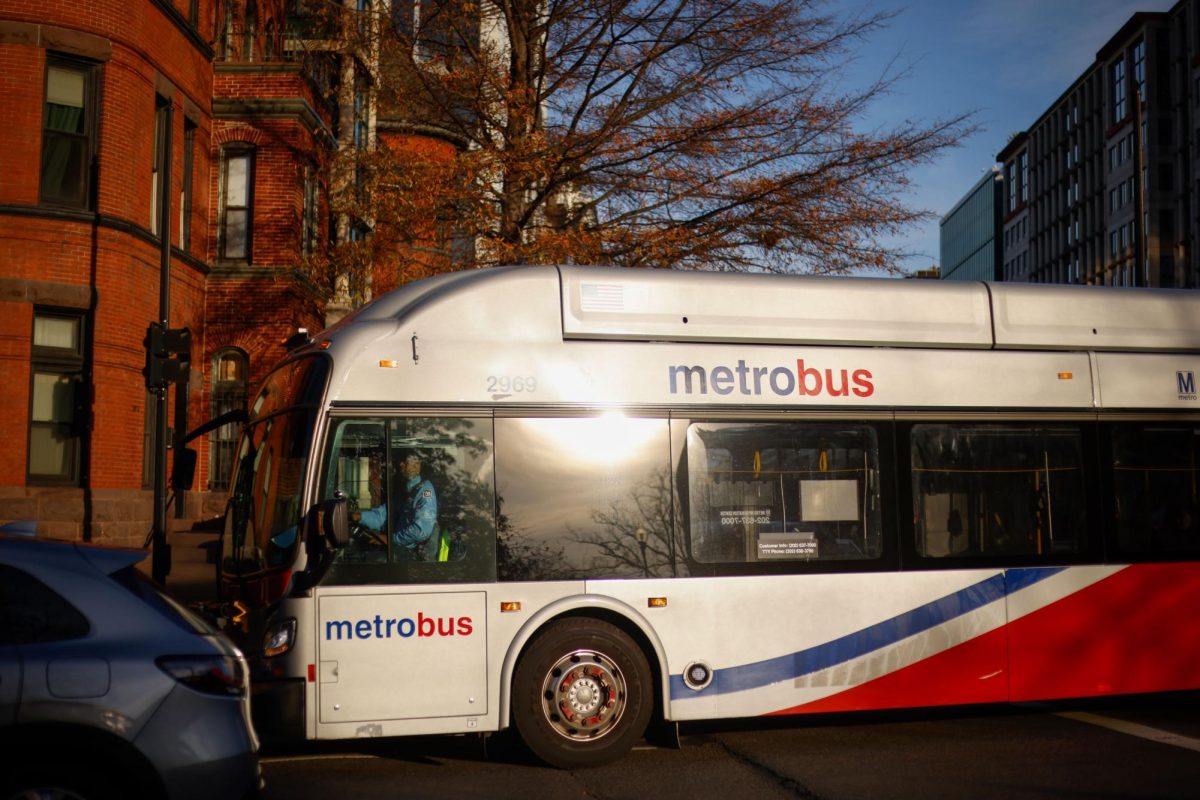The Washington Metropolitan Area Transit Authority finalized a plan late last month to adjust routes and schedules for D.C.’s bus system, extending two routes in the plan’s first draft after Foggy Bottom community members worried the plan would reduce their access to public transportation.
WMATA’s Board of Directors on Nov. 21 approved the Better Bus Network, the first comprehensive Metrobus redesign, which will go into effect in June to boost the number of frequent service routes, eliminate 500 underused bus stops and extend bus services to low-income neighborhoods. Facing backlash from Northwest D.C. residents over its initial June plan to cut the 42 and 43 bus routes — which residents said would reduce service to the Kennedy Center, Department of State and Columbia Plaza Apartments — WMATA’s November plan revised 70 of 125 routes and restored 150 stops, including in Foggy Bottom along 23rd Street and near the Kennedy Center, which community members said would better serve commuters.
WMATA opted to remove stops that are within 660 feet of another stop and lack ridership or those that are deemed unsafe for pedestrians due to a lack of access to crosswalks or sidewalks. The Better Bus Network will also add services to neighborhoods like Anacostia that have been in transit deserts.
The first draft, released in June, eliminated the 42 and 43 bus routes, which connect the Kennedy Center to the Mount Pleasant neighborhood with stops in Foggy Bottom on both Virginia Avenue and 23rd Street near the Columbia Plaza Apartments and the Department of State’s building. The plan’s proposed bus routes in the same direction only had Foggy Bottom pickup spots on 19th and 17th streets, blocks away from the 42 and 43 stops.
Data provided by the WMATA Office of Planning shows that the 42 and 43 routes in 2023 serviced a combined 37,922 riders who used UPass, a program providing full-time GW students unlimited use of Metro services for a discounted flat fee, making it the second highest-ridership route pair by UPass usage in the District and the most popular in Foggy Bottom. The proposed plan to cut the 42 and 43 was met with pushback from local community members and government officials.
The Foggy Bottom and West End Advisory Neighborhood Commission in June passed a resolution supporting the plan but urging WMATA to extend the proposed D72 route directly to Foggy Bottom, as the resolution states not doing so would force some residents to walk for as long as 30 minutes to access the service. The resolution was one of many from local governing bodies and organizations advocating to restore service to the Department of State, including ANC 1A in Columbia Heights.
Renee McPhatter, GW’s associate vice president for Government and Community Relations, raised concerns to the chief executive officer of WMATA in a written comment on July 15, saying the new routes would “deprive” the Foggy Bottom community of cost-effective transportation.
“Many staff and faculty members depend on Metro buses to come to work, and students (who are forbidden under the university’s Campus Plan to bring cars to campus) frequently use the bus system to visit other parts of the city for internships, entertainment and to take advantage of all that D.C. has to offer,” McPhatter said.
York Chow, who identified themself as a resident of Columbia Heights, said in a June testimony they and their husband, GW professor Jonathan Chow, rely on Routes 42 and 43 to transport between Northwest neighborhoods. Chow said losing the 42 and 43 would have been a “huge detriment” to their lives.
“We moved to that location primarily because of the 42, 43,” Chow said. “It makes it very easy for him to get to work, and it’s something that we rely on.”
In the final plan, the transit agency also renamed all bus routes with a letter representing their jurisdictions — like D for Downtown or C for Crosstown — a number identifying their corridors or neighborhoods and a final character to distinguish each as a ‘0’ for a primary route or an ‘X’ for a limited-route stop. WMATA said they opted to rename the stops after community feedback via an online survey on WMATA’s website in September deemed the existing naming conventions outdated.
Fred Simms, a D.C. bus transit historian who had worked for MetroBus for 45 years, said the old numbering system is based on four different private transit companies’ naming techniques, which Metro inherited when it took over the bus companies in 1973. He said tourists and residents found the lack of a uniform system confusing.
“Current bus route names reflect the history of different transit companies and their own naming techniques,” Simms said. “I’m excited that Metro is proposing a fresh approach to making the network naming more cohesive and easier to understand.”
The revised plan approved by the Metro Board of Directors on Nov. 21 sought to incorporate more than 13,000 comments and hundreds of letters sent by individuals and organizations into the final proposal for the Better Bus Network. The final product dropped the number of recommended stop eliminations by over 100 and altered more than half of the proposed routes, WMATA said.

The agency didn’t restore the 42 and 43 routes but extended the D74 and D12 routes in Foggy Bottom. WMATA extended the D74 and D12 bus routes’ final drop-off spot from the Farragut West Metro station to the Kennedy Center but renamed D12 to D10. The D72, which the Foggy Bottom ANC asked WMATA to extend, remained unchanged.
ANC 2A01 Commissioner Yannik Omictin, who sponsored the resolution, said he was “grateful” that WMATA listened to the ANC and Foggy Bottom community members’ concerns and extended the D74 bus, connecting Foggy Bottom to Columbia Heights and Dupont Circle. He added that he appreciated that the adjusted routes include stops along 23rd Street, which the plan’s first draft would have removed.
“Without the community raising its voice to demand a better plan for our neighbors, WMATA would never have changed their plans,” Omictin said in a message.
The D.C. Circulator terminated their Rosslyn-Dupont Circle and late-night Georgetown-Union Station services in October — both of which passed through Foggy Bottom. The remaining Circulator routes will end in December, with WMATA set to adjust a number of routes to compensate for reduced service. Ward 1 Councilmember Brianna Nadeau said in September that the Better Bus Network would be enhanced to preserve the connections.
Nicole Akumatey contributed reporting.





